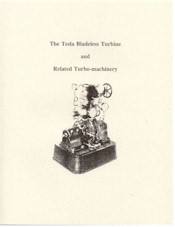 |
 DESCRIPTION: DESCRIPTION:
This offering features a chapter titled "The Bladeless
Turbine" by C.R. Possell and a compilation of Tesla's "Fluid Propulsion"
patent application, including amendments. Also included is the "Valvular
Conduit" patent, containing, among other things, Tesla's own operational description
of the bladeless gas turbine and an abridged version of his 1931 article entitled
"Our Future Motive Power" which describes a plan for converting the heat of the
earth itself into electrical energy. The book has 21 mechanical drawings of Tesla engines
and pumps, plus photos. It is a good primer for anyone interested in learning about this
"monarch of machines."
FOREWORD:
"Briefly stated, Tesla's motor consists of a set of flat steel disks mounted on a shaft and rotating within a casing, the steam [or gaseous products of combustion] entering with high velocity at the periphery of the disks, flowing between them in free spiral paths, and finally escaping through exhaust ports at their center. Instead of developing the energy of the steam [or gas] by pressure, reaction, or impact, on a series of blades or vanes [or pistons], Tesla depends upon the fluid properties of adhesion and viscosity--the attraction of the steam to the faces of the disks and the resistance of its particles to molecular separation combining in transmitting the velocity energy of the motive fluid to the plates and the shaft." -- Scientific American
EXCERPTS:
The Ideal Prime Mover
"The theoretically perfect turbine would be one in which the fluid was so controlled from the inlet to the exhaust that its energy was delivered to the driving shaft with the least possible losses due to the mechanical means employed. The mechanically perfect turbine would be one which
combined simplicity and cheapness of construction, durability, ease and rapidity of repairs, and a small ratio of weight and space occupied to the power delivered on the shaft."
Dr. Tesla maintained that his engine, operating either with steam or as a gas motor, took long step toward both of these ideals, theoretical as well as mechanical. In fact, he stated in the U.S. Valvular Conduit patent that, "such a machine is a thermodynamic transformer of an activity surpassing by far that of any other prime mover." In terms of mechanical simplicity the disk turbine design and its relative ease of construction speak for themselves in terms of economy. It should be noted that one key to production of the super-efficient turbine of the future lies in the use of new high performance materials in their manufacture. This is especially true regarding construction of the turbine's rotor. While the development of high temperature ceramics is critical to this end, it is becoming apparent that in order to assure adequate
strength, the final product will most likely incorporate rotors to be manufactured from a fiber infused composite material. Promising developments in this area are already being made by engineers working on improvements in conventional turbine hub design. In his 1919 autobiography My Inventions Tesla anticipated a time when this marvelous engine would be put into use. He did this by comparing it with an earlier invention for which he is better known:
"A new idea must not be judged by its immediate results. My alternating system of power transmission came at a psychological moment, as a long-sought answer to pressing industrial
questions and altho considerable resistance had to be overcome and opposing interests reconciled, as usual, the commercial introduction could not be long delayed. Now, compare this situation with that confronting my turbine, for example. One should think that so simple and beautiful an invention, possessing many features of an ideal motor, should be adopted at once and, undoubtedly it would be under similar conditions. But the prospective effect of the rotating field was not to render worthless existing machinery; on the contrary, it was to give it additional value. The system lent itself to new enterprise as well as to improvement of old. My turbine is of a character entirely different. It is a radical departure in the sense that its success would mean the abandonment of the antiquated types of prime movers on which billions of dollars have been spent. Under such circumstances the progress must needs be slow..."
With three quarters of a century having passed, perhaps now is the right psychological moment. . . .
TABLE OF CONTENTS:
Foreword
The Tesla Bladeless Turbine
Nikola Tesla
The Geothermal Connection
Nikola Tesla
Valvular Conduit Patent
Nikola Tesla
Tesla's New Mechanical Principle
The Automobile, Nov. 30, 1911
The Bladeless Turbine
C.R. Possell
Assembly Drawings
|

|
![]()